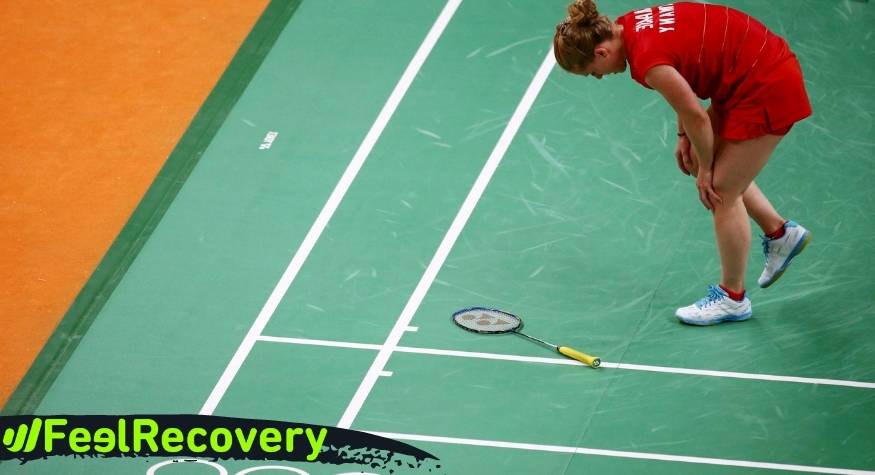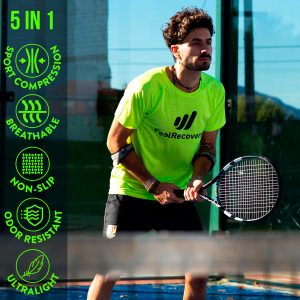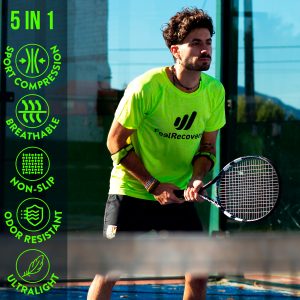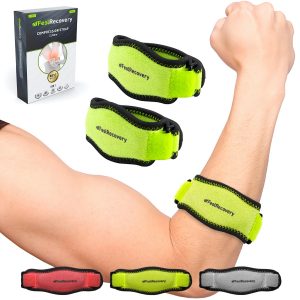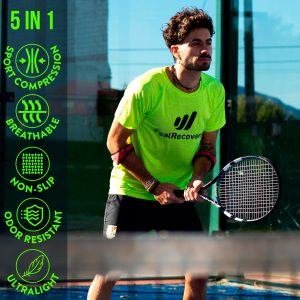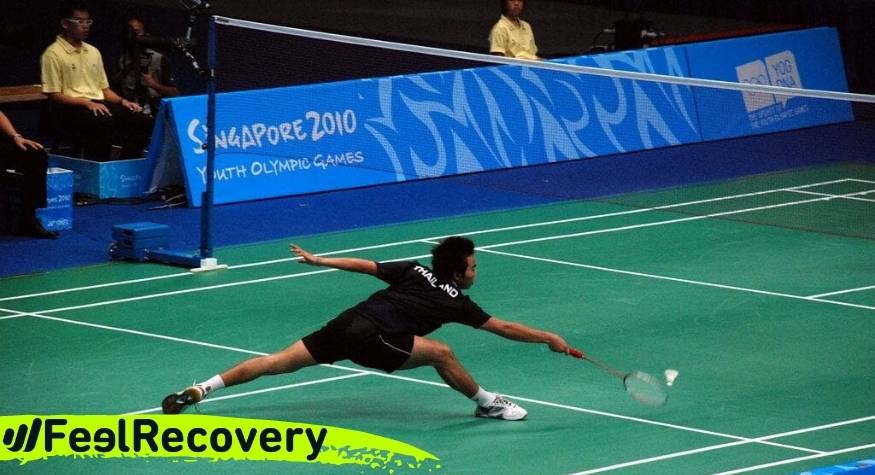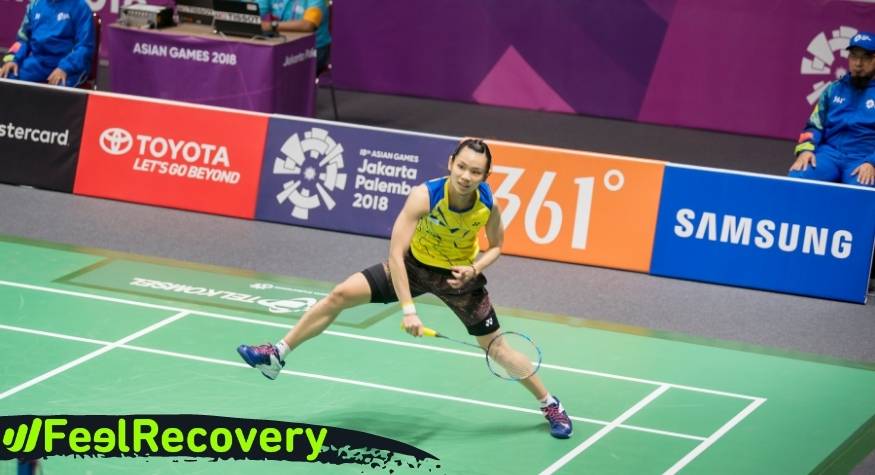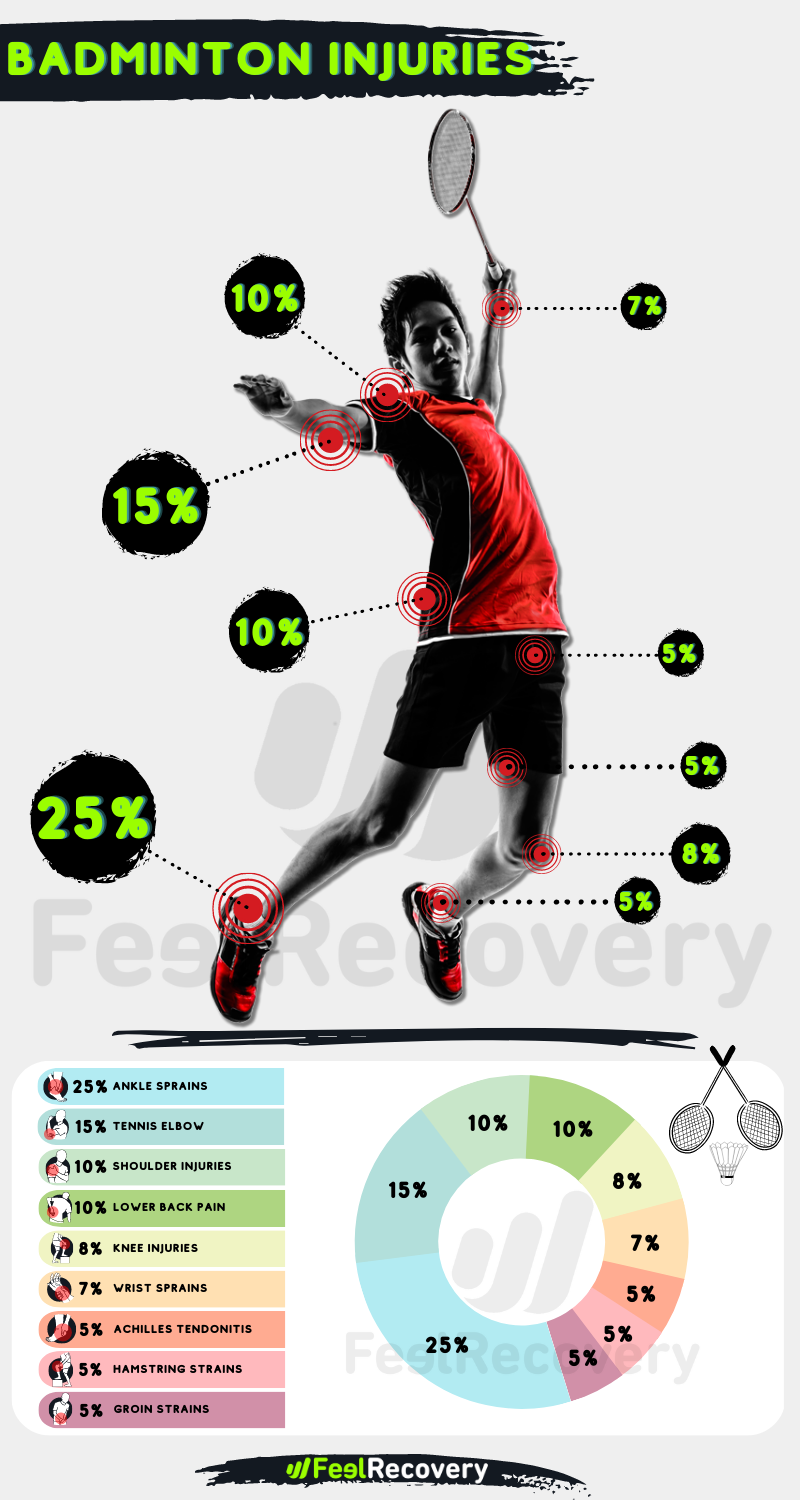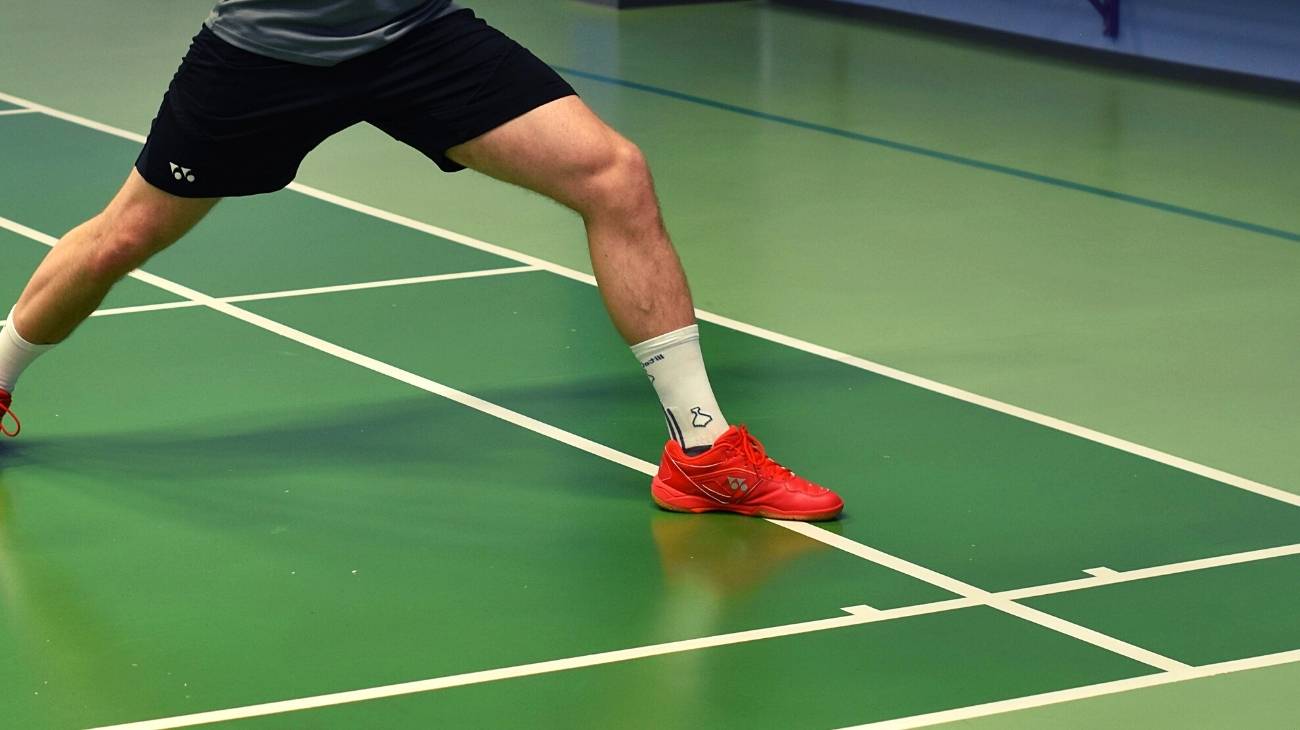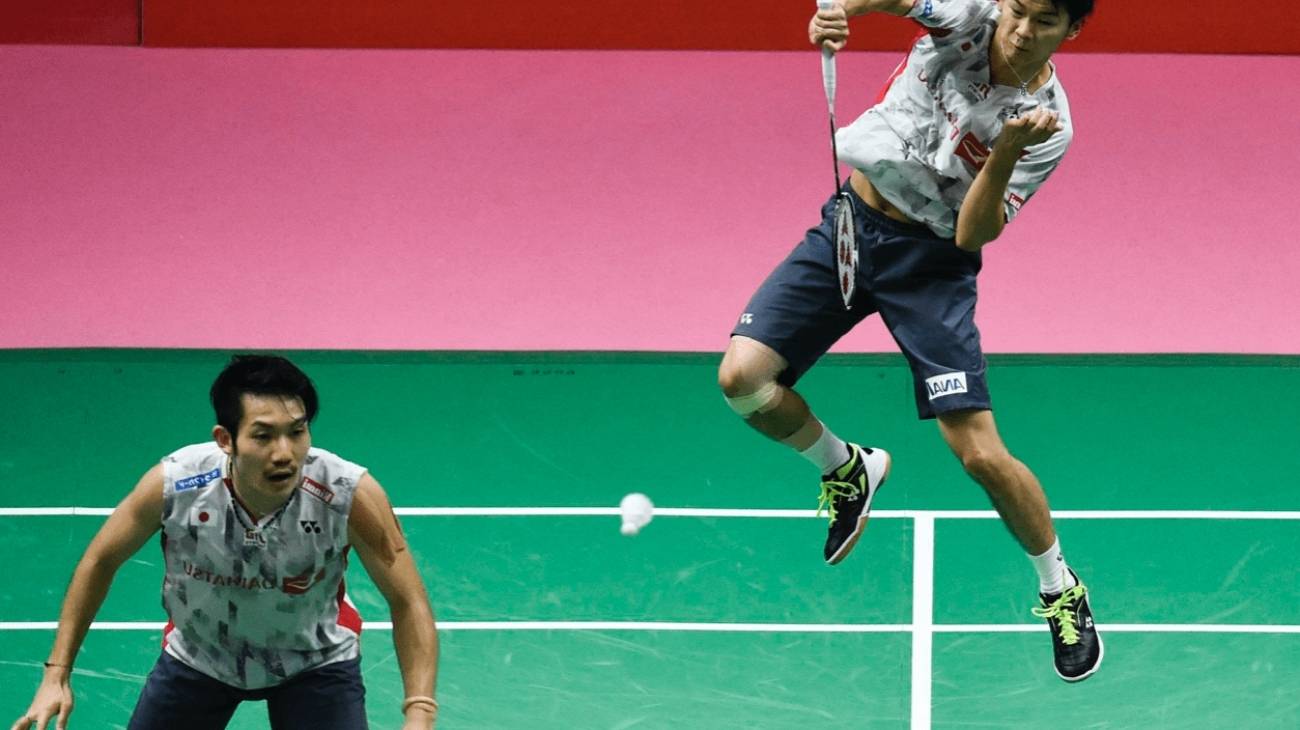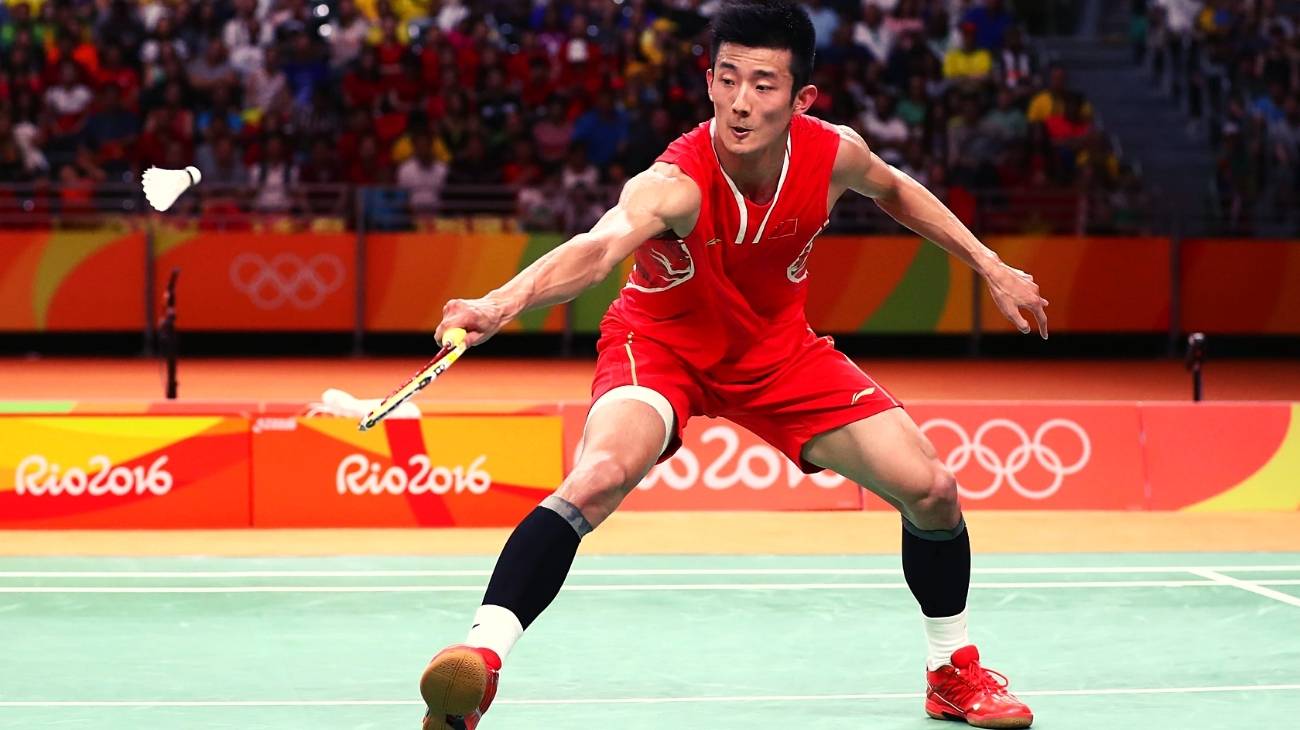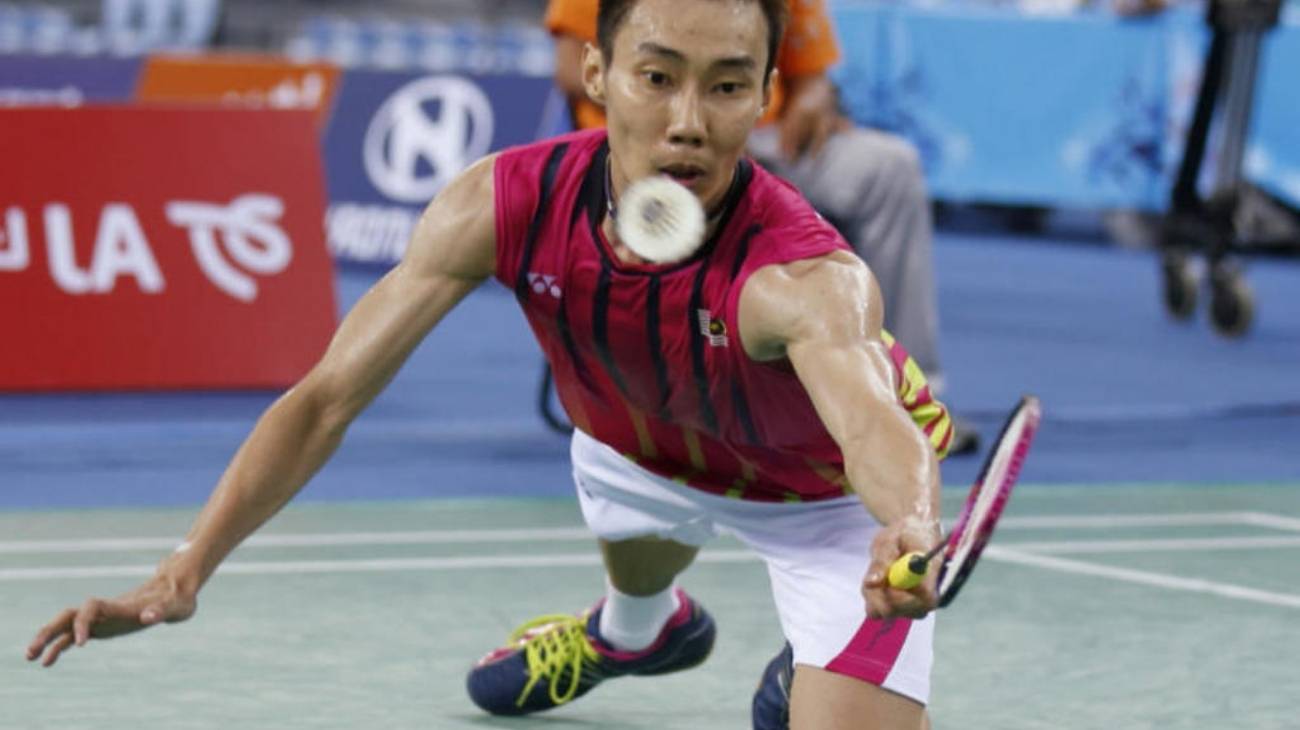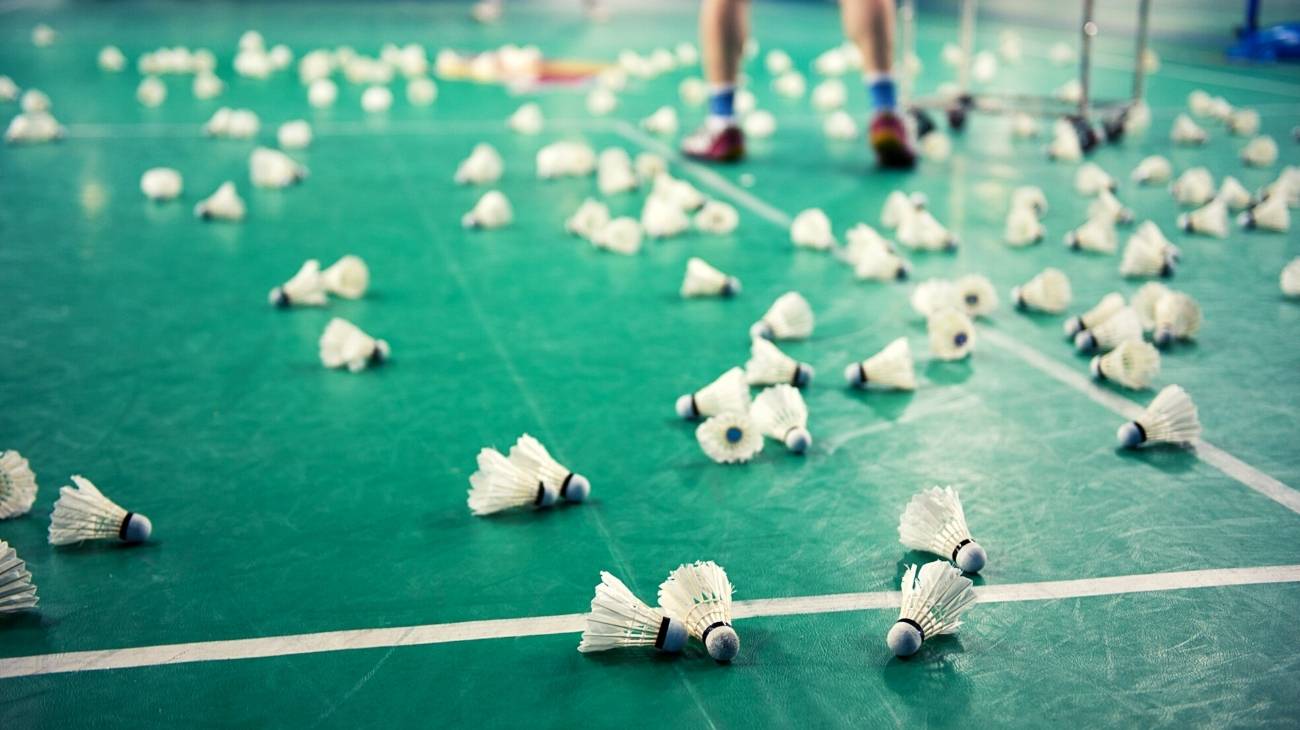- What are the most common types of injuries when playing badminton?
- Best products for badminton injury recovery
- How to prevent injuries when playing badminton?
- How to apply the RICE therapy to treat first aid injuries in badminton?
- When should we see a specialist doctor for the treatment of badminton injuries?
Badminton is one of the most demanding sports in the world, largely due to its similarities to tennis. Being in a match demands a lot from us physically, so we must always be in the best possible shape.
Therefore, it is important to minimise the risk of injury as much as possible, as the slightest ailment could cause us many problems when it comes to exploiting our full potential. Here we are going to give you all the information about the different badminton injuries, how to prevent them and how to treat them from zero.
What are the most common types of injuries when playing badminton?
Many injuries are caused by the constant strain we put on our muscles and joints. Here are the most common ones.
Rotator cuff tendonitis
The shoulder has 4 tendons that connect the so-called rotator cuff to the muscle complex in the same area. Tendonitis refers to an irritation or inflammation of these tendons, which causes a lot of pain, and especially a rather pronounced reduction in mobility.
This injury is one of the most common in badminton, as the shoulder and its rotator cuff is the part of the body that we use the most during the whole game. This injury is caused by subjecting the shoulder tendons to too much wear and tear, so most specialists, if the injury is not too severe, recommend complete rest until the joint repairs itself.
Tennis elbow (lateral epicondylitis)
In our elbows there is a bone called the epicondyle, which is responsible for connecting the forearm muscles to the elbow. It is a small bone on the outer side of both elbows and can be felt very easily. Epicondylitis occurs when there is inflammation or irritation of the epicondyle muscles.
Epicondylitis is very easy for a medical specialist to diagnose, as the symptoms are very characteristic; from pain on the outside of the elbow and a slight inflammation, to the impossibility to perform all the mechanics of this part of the body. The RICE therapy is usually recommended.
Tendonitis of the wrist
As in the shoulder, there are a series of tendons that connect our hands to our forearms, right in the wrist area. When these are subjected to a lot of recurrent wear and tear, two problems tend to occur; a ganglionoma, which is a lump of fluid that breaks away from the joint, or the tendons become irritated and inflamed, leading to tendonitis in the wrist.
Although it is one of the easiest injuries to treat, it is also the most annoying because it greatly reduces mobility in the wrist, and as it is an area with more nerves involved, the sensation of pain is very acute, in many cases so unbearable that the solution is to completely immobilise the patient's hand.
Knee sprains
In all high-impact sports, the knee is one of the parts of our anatomy that suffers the most, because it is where we put almost all the weight and tension of our body in each movement. A sprain occurs when one or more of the 4 tendons of the joint are violently contracted either by a bad movement or by a blow.
The 4 tendons involved are; external lateral ligament, internal lateral ligament, anterior cruciate ligament and posterior cruciate ligament, and depending on which ones are injured, the severity of the injury and treatment is determined. The sprain can be partial or complete and in 90% of cases it is solved with non-invasive therapies without surgery, unless the sprain has caused a complete rupture of the ligaments.
Patellar tendonitis
Another lower body injury caused by badminton is tendonitis of the patellar tendon that connects the knee to the kneecap. This injury is usually caused by sessions in which our knee has been subjected to a lot of stress, causing irritation in this tissue and subsequent irritation.
The treatment for this type of injury is a lot of rest and a series of self-massages accompanied by the use of a compression garment such as a knee brace. It is important to stop when you feel discomfort in the kneecap because if we ignore it, we can cause a much more serious injury in the future.
Ankle sprains
One of the most common injuries in all high-impact sports is the ankle sprain, which is caused when we make an unnatural movement or twist of the ankle joint, resulting in slight damage to the tendons that connect the foot and calf muscles.
The sprain can be partial, in which the damage is almost superficial, or complete, in which the entire tendon has suffered severe damage. In both cases, non-invasive treatments are chosen in which it is not necessary to go to the operating theatre and recovery is more natural.
Plantar fasciitis
Plantar fasciitis refers to inflammation in the tendons that connect the heel to the toes. As an area where the entire weight of the body is supported, these tendons are always under stress, which is magnified when playing impact sports such as badminton.
Plantar fasciitis is easy to recognise by the stabbing pain it causes in the sole of the foot near the heel, which can be so painful that it prevents us from supporting the foot naturally. What is recommended in most cases is complete rest (which includes not playing for a while) and self-massage until the tendon recovers.
Stress fractures
Undoubtedly the most serious injury an athlete can suffer is a bone fracture. Although in badminton these are not at all common, as it is unlikely to receive a blow so forceful as to injure a bone, or to make a move so bad that you end up fracturing it yourself.
However, whatever the cause of such a serious injury, it is important to see your GP as soon as possible to start rehabilitation immediately.
Best products for badminton injury recovery
Bestseller
-
2 Ankle Compression Sleeve (Green/Navy)
£20,95 -
2 Elbow Compression Sleeve (Black/Gray)
£20,95 -
2 Elbow Compression Sleeve (Green/Navy)
£20,95 -
2 Elbow Compression Sleeve (Pink/Bordeaux)
£20,95 -
2 Knee Compression Sleeve (Black/Gray)
£20,95 -
2 Knee Compression Sleeve (Green/Navy)
£20,95 -
2 Knee Compression Sleeve (Pink/Bordeaux)
£20,95 -
2 Thigh Compression Sleeve (Black/Gray)
£20,95 -
2 Thigh Compression Sleeve (Green/Navy)
£20,95 -
2 Thigh Compression Sleeve (Pink/Bordeaux)
£20,95 -
Microwaveable Wheat Bag for Pain Relief (Hearts)
£20,95 -
Microwaveable Wheat Bag for Pain Relief (Oxford)
£20,95 -
Microwaveable Wheat Bag for Pain Relief (Sport)
£20,95 -
Wheat Bag for Microwave Classic Bottle Shaped (Hearts)
£20,95 -
Wheat Bag for Microwave Classic Bottle Shaped (Oxford)
£20,95 -
Wheat Bag for Microwave Classic Bottle Shaped (Sport)
£20,95
-
2 Ankle Compression Sleeve (Black/Gray)
£20,95 -
2 Ankle Compression Sleeve (Pink/Bordeaux)
£20,95 -
2 Patella Knee Strap (Black/Gray)
£12,95 -
2 Patella Knee Strap (Green/Navy)
£12,95 -
2 Patella Knee Strap (Pink/Bordeaux)
£12,95 -
2 Tennis Elbow Brace (Black/Gray)
£12,95 -
2 Tennis Elbow Brace (Green/Navy)
£12,95 -
2 Tennis Elbow Brace (Pink/Bordeaux)
£12,95 -
Foot Massage Roller for Plantar Fasciitis (Black)
£20,95 -
Foot Massage Roller for Plantar Fasciitis (Green)
£20,95 -
Foot Massage Roller for Plantar Fasciitis (Pink)
£20,95 -
Ice Massage Roller Ball (Black)
£34,95 -
Ice Massage Roller Ball (Green)
£34,95 -
Ice Massage Roller Ball (Pink)
£34,95 -
Shoulder Support Brace (Black)
£24,95 -
Shoulder Support Brace (Green)
£24,95 -
Shoulder Support Brace (Pink)
£24,95 -
Soft Density Foam Roller for Recovery (Black)
£34,95 -
Soft Density Foam Roller for Recovery (Green)
£34,95 -
Soft Density Foam Roller for Recovery (Pink)
£34,95
How to prevent injuries when playing badminton?
Preventing injuries is the best option for any professional or amateur badminton player. This has a lot to do with the preparation we give our body, not only in its nutrition, but also in many other habits that we must always keep in mind and that we are going to discuss below.
Warming up
Warming up is a series of gentle and moderate intensity exercises that are done to activate the muscles of the body, especially those we are going to need for our badminton game. As this is a sport of short, explosive movements, it is very important that both the muscles of our lower body and the muscles of our upper joints are well prepared.
The classic badminton warm-up includes general stretching, then jogging around the badminton court for a few laps, then simulating some basic movements on the court, and finishing with shooting practice. With this and little else you will be ready to start your game and reduce the vast majority of injuries to a minimum.
Cool down
Many people pay a lot of attention to warming up, but not to cooling down. This refers to the way in which we gradually relax the body after a match or a heavy training session. This is not only true for badminton, but for all sports.
In badminton, stretching sessions of the whole body are usually carried out in a gentle and relaxed way, as well as regulating breathing to lower our heart rate. Medical specialists recommend doing this activity always after every game or training session, regardless of its intensity.
The right equipment
It is important to always have the right equipment for the sport you are playing. Badminton requires 3 essentials; rackets, pens and shoes, as well as of course comfortable clothing that does not restrict mobility.
Many people have suffered severe wrist injuries from using the wrong racket or pulling a tennis ball because it has no feathers. So it is always best to make the investment of buying all the equipment we need to avoid injury as much as possible.
Nutrition and hydration
As a very high intensity sport, diet and hydration play a key role in muscle performance and strength. In terms of food, we should consume plenty of carbohydrates as this is where we will get most of our energy. This includes cereals such as rice or quinoa as a main dish, as well as potatoes, pulses, fruit and vegetables of all kinds, but not forgetting lean proteins such as red meat, fish, eggs and dairy products.
There is a formula for calculating exact amounts of food according to the intensity with which we train. For carbohydrates, between 5 and 10 grams per kilogram of body weight are recommended, while for proteins, between 1.2 and 1.4 grams per kilogram of body weight are required. In other words, a 70 kg person should consume around 500 g of carbohydrates and 100 g of protein per day.
As far as hydration is concerned, it is important to maintain water levels in our bodies in order to have healthy muscles and joints. However, it is bold to talk about specific quantities, so this issue should always be discussed with a nutritionist, especially to determine the doses of liquid to be ingested during matches.
Physical fitness
To give a good level in badminton and any other sport, we must take into account the demands of the sport. In this sense, if we want to give a good show in every game, we need to accompany these goals with our fitness. This means that we have to train regularly.
Badminton training routines can be divided into two types; physical and technical. The former focus on working on the player's fitness, with medium and high intensity cardio sessions that can be on a stationary bike, jogging and running, and many other ways. Also, constant stretching and mobility sessions to maintain an agile and flexible body.
As for simulation exercises, these are sessions in which we practice shooting and other common situations that would happen in a match. The most important are movement exercises, and serve and return simulations.
Recovery therapies
If after doing everything we recommend you have not been able to avoid a nagging injury, you need to know everything important to start your recovery.
- Sports massage: This is a series of relaxing massages to stimulate muscle recovery after an injury. Sessions vary depending on the area of injury, and should always be assigned by a physiotherapist.
- Use of hot/cold therapies: One of the most recommended practices is the combination of cold and heat to treat an injury, especially in the first days when the pain is very acute.
- Use of compression garments: The use of special compression garments can improve the speed of recovery from injury.
- Use of acupressure therapies: This therapy is closely linked to acupuncture, with the difference that it is not carried out with needles but by applying pressure on the so-called trigger points. The manipulation is done with the hands and focuses on local trigger points, i.e. where there is pain.
- Use of thermotherapy: Thermotherapy treats injuries and muscle fatigue, achieving a real therapeutic effect on the pain and an excellent relaxant. Its mechanism of action is through vasodilation caused by heat at muscular level.
- Use of cryotherapy: This generates the effect of vasoconstriction, reducing pain and inflammation, being very useful and preventing further damage in sports injuries.
How to apply the RICE therapy to treat first aid injuries in badminton?
RICE stands for Rest, Ice, Compression and Elevation, which refers to four fundamental first aid steps for badminton injuries and any other sport. A few years ago, they also added the protection section, so athletes know this method as PRICE and it stands for: Protection, Rest, Ice, Compression and Elevation.
Here we show you what to do in each of the steps that the therapy requires:
- Protection: at this point the first thing to do is to protect the injured area, either with a tourniquet in the case of a fracture, or a bandage if it is a contracture or sprain.
- Rest: the next thing to do is to completely immobilise the area of the injury, and not moving it is of the utmost importance until the extent of the injury is determined. The less we use the joint, the faster it can recover.
- Ice: cold is one of our best allies, especially in the first moments of the injury, as it reduces swelling and pain. Applying ice every day for at least 15 minutes will help to make the rehabilitation process more pleasant.
- Compression: using an elastic bandage or a specialised compression garment for the injured area of the body, such as a knee or elbow brace, prevents swelling and keeps the muscle and tendons stable while they recover properly.
- Elevation: elevating the injured part above the level of your heart will reduce swelling quickly as blood flow will be slightly reduced. Resting always in a position favourable to this principle will be essential to speed up recovery as much as possible.
When should we see a specialist doctor for the treatment of badminton injuries?
So far we have shown you ways in which you can rehabilitate yourself, but there are cases in which it will be necessary to go to a health specialist to guide us out of the ordeal of a serious injury.
An example of this would be any fracture or broken bone. In these cases it will inevitably be necessary to consult a professional for both diagnosis and subsequent rehabilitation.
It will also be necessary to consult a medical specialist if we notice that the recovery process of that injury that we thought was small is not going well and is taking too long to heal. Otherwise, we risk the injury escalating into a serious chronic problem.
References
- Krøner, K., Schmidt, S. A., Nielsen, A., Yde, J., Jakobsen, B. W., Møller-Madsen, B., & Jensen, J. (1990). Badminton injuries. British journal of sports medicine, 24(3), 169-172. https://bjsm.bmj.com/content/24/3/169.short
- Fahlström, M., Björnstig, U., & Lorentzon, R. (1998). Acut badminton injuries. Scandinavian Journal of Medicine & Science in Sports, 8(3), 145-148. https://onlinelibrary.wiley.com/doi/abs/10.1111/j.1600-0838.1998.tb00184.x
- Jørgensen, U., & Winge, S. (1987). Epidemiology of badminton injuries. International journal of sports medicine, 8(06), 379-382. https://www.thieme-connect.com/products/ejournals/abstract/10.1055/s-2008-1025689
- Hensley, L. D., & Paup, D. C. (1979). A survey of badminton injuries. British Journal of Sports Medicine, 13(4), 156-160. https://bjsm.bmj.com/content/13/4/156.short
- Pardiwala, D. N., Subbiah, K., Rao, N., & Modi, R. (2020). Badminton injuries in elite athletes: A review of epidemiology and biomechanics. Indian journal of orthopaedics, 54(3), 237-245. https://link.springer.com/article/10.1007/s43465-020-00054-1
- Jørgensen, U., & Winge, S. (1990). Injuries in badminton. Sports Medicine, 10, 59-64. https://link.springer.com/article/10.2165/00007256-199010010-00006
- Goh, S. L., Mokhtar, A. H., & Mohamad Ali, M. R. (2013). Badminton injuries in youth competitive players. J Sports Med Phys Fitness, 53(1), 65-70. https://www.researchgate.net/profile/Siew-Li-Goh-2/publication/235885246_Badminton_injuries_in_youth_competitive_players/links/57484a8608ae707fe21fbb10/Badminton-injuries-in-youth-competitive-players.pdf
- Muttalib, A., Zaidi, M., & Khoo, C. (2009). A survey on common injuries in recreational badminton players. Malaysian Orthopaedic Journal, 3(2), 8-11. https://citeseerx.ist.psu.edu/document?repid=rep1&type=pdf&doi=ba75ad32fb698b19e4fb3d1d8c735616e3a6993d
- Fu, L., Ren, F., & Baker, J. S. (2017). Comparison of joint loading in badminton lunging between professional and amateur badminton players. Applied Bionics and Biomechanics, 2017. https://www.hindawi.com/journals/abb/2017/5397656/
- Feng, B., & Wang, X. (2022). Study on sports injuries and rehabilitation in badminton players. Revista Brasileira de Medicina do Esporte, 29. https://www.scielo.br/j/rbme/a/PCH35GrCYHVnLZzmzMbgrZq/abstract/

